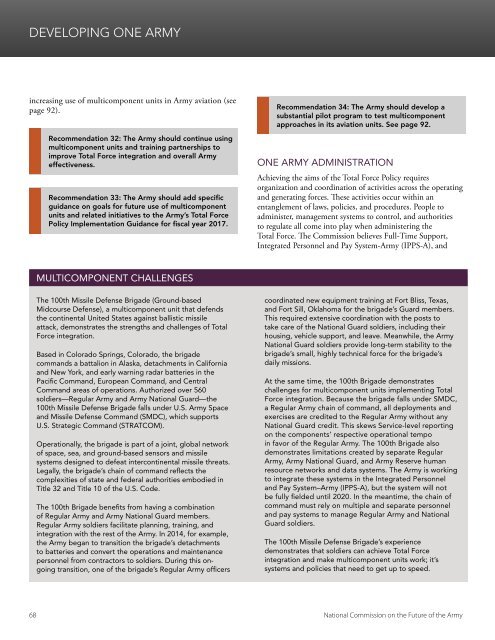THE FUTURE OF THE ARMY
NCFA_Full%20Final%20Report_0
NCFA_Full%20Final%20Report_0
Create successful ePaper yourself
Turn your PDF publications into a flip-book with our unique Google optimized e-Paper software.
DEVELOPING ONE <strong>ARMY</strong><br />
increasing use of multicomponent units in Army aviation (see<br />
page 92).<br />
Recommendation 32: The Army should continue using<br />
multicomponent units and training partnerships to<br />
improve Total Force integration and overall Army<br />
effectiveness.<br />
Recommendation 33: The Army should add specific<br />
guidance on goals for future use of multicomponent<br />
units and related initiatives to the Army’s Total Force<br />
Policy Implementation Guidance for fiscal year 2017.<br />
Recommendation 34: The Army should develop a<br />
substantial pilot program to test multicomponent<br />
approaches in its aviation units. See page 92.<br />
ONE <strong>ARMY</strong> ADMINISTRATION<br />
Achieving the aims of the Total Force Policy requires<br />
organization and coordination of activities across the operating<br />
and generating forces. These activities occur within an<br />
entanglement of laws, policies, and procedures. People to<br />
administer, management systems to control, and authorities<br />
to regulate all come into play when administering the<br />
Total Force. The Commission believes Full-Time Support,<br />
Integrated Personnel and Pay System-Army (IPPS-A), and<br />
MULTICOMPONENT CHALLENGES<br />
The 100th Missile Defense Brigade (Ground-based<br />
Midcourse Defense), a multicomponent unit that defends<br />
the continental United States against ballistic missile<br />
attack, demonstrates the strengths and challenges of Total<br />
Force integration.<br />
Based in Colorado Springs, Colorado, the brigade<br />
commands a battalion in Alaska, detachments in California<br />
and New York, and early warning radar batteries in the<br />
Pacific Command, European Command, and Central<br />
Command areas of operations. Authorized over 560<br />
soldiers—Regular Army and Army National Guard—the<br />
100th Missile Defense Brigade falls under U.S. Army Space<br />
and Missile Defense Command (SMDC), which supports<br />
U.S. Strategic Command (STRATCOM).<br />
Operationally, the brigade is part of a joint, global network<br />
of space, sea, and ground-based sensors and missile<br />
systems designed to defeat intercontinental missile threats.<br />
Legally, the brigade’s chain of command reflects the<br />
complexities of state and federal authorities embodied in<br />
Title 32 and Title 10 of the U.S. Code.<br />
The 100th Brigade benefits from having a combination<br />
of Regular Army and Army National Guard members.<br />
Regular Army soldiers facilitate planning, training, and<br />
integration with the rest of the Army. In 2014, for example,<br />
the Army began to transition the brigade’s detachments<br />
to batteries and convert the operations and maintenance<br />
personnel from contractors to soldiers. During this ongoing<br />
transition, one of the brigade’s Regular Army officers<br />
coordinated new equipment training at Fort Bliss, Texas,<br />
and Fort Sill, Oklahoma for the brigade’s Guard members.<br />
This required extensive coordination with the posts to<br />
take care of the National Guard soldiers, including their<br />
housing, vehicle support, and leave. Meanwhile, the Army<br />
National Guard soldiers provide long-term stability to the<br />
brigade’s small, highly technical force for the brigade’s<br />
daily missions.<br />
At the same time, the 100th Brigade demonstrates<br />
challenges for multicomponent units implementing Total<br />
Force integration. Because the brigade falls under SMDC,<br />
a Regular Army chain of command, all deployments and<br />
exercises are credited to the Regular Army without any<br />
National Guard credit. This skews Service-level reporting<br />
on the components’ respective operational tempo<br />
in favor of the Regular Army. The 100th Brigade also<br />
demonstrates limitations created by separate Regular<br />
Army, Army National Guard, and Army Reserve human<br />
resource networks and data systems. The Army is working<br />
to integrate these systems in the Integrated Personnel<br />
and Pay System–Army (IPPS-A), but the system will not<br />
be fully fielded until 2020. In the meantime, the chain of<br />
command must rely on multiple and separate personnel<br />
and pay systems to manage Regular Army and National<br />
Guard soldiers.<br />
The 100th Missile Defense Brigade’s experience<br />
demonstrates that soldiers can achieve Total Force<br />
integration and make multicomponent units work; it’s<br />
systems and policies that need to get up to speed.<br />
68 National Commission on the Future of the Army


